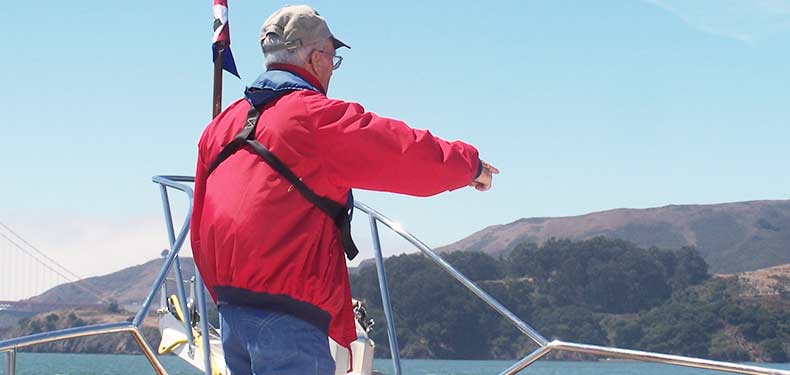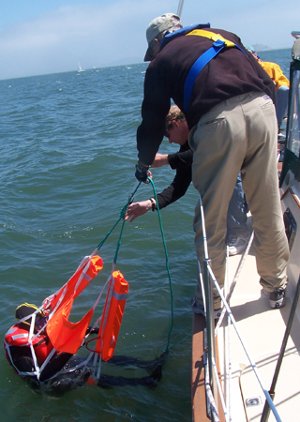Testing Crew Overboard Maneuvers
Foundation Findings #41 - November 2005
For three days, BoatU.S. Foundation staff attended the 2005 Crew Overboard Retrieval Symposium, of which it was a co-sponsor. Held at the Modern Sailing Academy in Sausalito, CA, the event drew over 100 people, including sailing instructors; members of the press; device manufacturers; international participants from France, Japan, Germany, Canada, and Iceland; a senior official in the Coast Guard's safety office; and two senior members of the sailing staff at the Naval Academy. Many friends, colleagues, and local sailors also came as volunteers.
Over 400 exercises were performed, and no one stood on the sidelines. Crews were made up of all who were present, which meant press members teamed with manufacturers, and local racers with sponsors. Over four days our own two staff members served as crew on a Grand Banks 42, Beneteau 43, and an Island Packet 38, and on two separate safety boats.
During testing, hundreds pages of written observations were collected, thousands of photos taken, four days of GPS tracks were recorded, and dozens of rescues were videotaped. It will still take some time yet to analyze the massive amounts of data, but in the meantime, we invite you to read our first impressions in Foundation Findings #41, and view the photo gallery here for some lessons learned.
More than 100 seasoned sailors and powerboaters, from international racers to high-level instructors, converged this summer in the shadow of the Golden Gate Bridge to test crew overboard maneuvers and products. For four days on San Francisco Bay near Sausalito, crews made up of boating heavyweights and local blokes alike hit the water, along with volunteer "victims" who bravely agreed to jump in the chilly Pacific waters for the good of boating.
Each boat's crew conducted planned tests on the three main elements of a crew-overboard rescue: maneuvering back to the victim, making contact, and re-boarding. A total of 15 boats participated, including eight mono-hull and four multi-hull sailboats, and three powerboats. BoatU.S. Foundation staff particularly wanted to see how these practice rescues played out on a powerboat.
All of this was part of a Crew Overboard Retrieval Symposium sponsored by the Bonnell Cove Foundation, the BoatU.S. Foundation, West Marine and the Modern Sailing Academy, with additional support by North Sails and the Sailing Foundation of Seattle. All the on-the-water participants wore life jackets and/or wet suits.

Power Play
Sailors have their choice of crew-overboard maneuvers to employ - the Figure Eight and Quick Stop, just to name two. But powerboats are different. There are no widely-accepted maneuvers. "That's why it was important to include powerboats in this series of tests," said BoatU.S. Foundation President Ruth Wood. Also, safely getting close enough to make contact with an overboard victim, with one or two propellers whirling away, was an issue in need of investigation. And finally, there was the issue of re-boarding. Ask most power-boaters how to get a person back on board, and they'll point to the swim platform. But what if the water is choppy or the victim is unconscious? How useful is a swim platform then?
Two Boats, Two Approaches
Our staff members spent some time aboard sailboats, but took special interest in tests on two very different powerboats. One was a Grand Banks 42 with a swim platform and an electric dinghy davit aft of the fly bridge. The other was a lobster boat-style Fortier 26 with no means of securing lifting tackle. Crews tested these boats over two days, during variable winds that ranged from 18 to 25 knots and sea conditions ranging from flat to a two- to three-foot chop.

During testing on the Grand Banks, owner Gerry Ramsey primarily had the helm, backed by three crew. To test maneuvers getting back to the victim, the captain first brought the boat to eight knots. A tester on the stern of the boat threw out a retrieval dummy - a Styrofoam mannequin head attached to a weighted rod - and yelled "Man overboard!" The captain immediately began a wide arch back to the victim without reducing speed. Right away we discovered that this gets the boat back to the victim quickly, but creates a lot of chop and frothy wash that made it hard to see the dummy. After several tests at high speeds, the captain tried reducing speed immediately, then returned to the victim slowly. This did not seem to take any less time and it created less chop - and anxiety.
On the Fortier, helmsman Phil Cowley of West Marine opted not to attempt a high-speed return. As soon as "crew overboard" was sounded, he brought the boat to idle and swung around, returning to within one or two boat lengths of the victim.
Making a Connection
When making contact with a live victim instead of a dummy, the Grand Banks captain discovered a technique that worked remarkably well for his boat. He slowly moved beside the victim on the windward side and stopped one to two boat lengths away, keeping the victim in the lee of the vessel. He shut off the starboard engine completely and put the port engine in neutral. Then, he allowed the boat to drift slowly toward the victim, creating a protected area and allowing time for the rescue.
The same technique, when tried on the Fortier 26, was not so successful. When stopping windward of the victim, the boat soon drifted too close, requiring the victim to fend off the boat's hull. When tried the opposite way, keeping the vessel to the leeward side, the boat and victim soon drifted too far apart. The most effective way of staying in one position, the crew found, was to put the boat’s bow into the wind. However, without the engine, the Fortier captain said it would have been very hard to safely make contact with the victim without throwing a device.

High and Dry
The Grand Banks and Fortier crews found the Lifesling (both the inherently buoyant and inflatable models) worked well to make contact with victims, as did a simple throw rope bag, and even "the Noodlevator" (invented sometime between day one and two of the event, we think, using swimming pool Styrofoam "noodles"). The Lifesling, in addition to being a throwing device, can be used on a sailboat to lift a victim onboard using a halyard or Lifesling lifting tackle. On the Grand Banks using the electric davit, the Lifesling easily raised a victim enough to make it over the high freeboard of this boat. On the Fortier, which lacked a means of attaching lifting tackle, using this gear was not possible.
The natural choice for re-boarding on the Grand Banks was the swim platform, which was at least six inches off the water. On at least one occasion, our live victim took one look at it pounding in the chop, and decided to board from the side instead. John Rousmaniere, author of The Annapolis Book of Seamanship and a member of the event's executive planning committee, observed. "It is a serious mistake to assume that a swim platform is a safe or reliable rescue platform," he said. "With a Grand Banks 42, even a two-foot chop caused enough rolling to make it a sledge hammer."
For side boarding, the plastic Plastimo Safety Ladder (pictured below) was effective, as were several prototype and hard-to-get products like the Markus scramble net and the Markus Net, brought by a distributor from Iceland. Given the Grand Bank's electric winch and the advanced crew, almost all products could be made to work well - but with practice. On the Fortier, the swim platform was used as the sole means of re-boarding. The platform on this boat was low to the water, and at times submerged, creating less of the "hammer effect" mentioned by Rousmaniere. This made the captain feel more comfortable about using it, at least for a strong, conscious victim.

Practice Makes Perfect
One lesson stands out, not only from the powerboat testing, but from all the 400+ exercises conducted over four days: The more times a maneuver was done or a product was used, the more successful the crew was at getting the victim back aboard.
"A message we repeat in just about every Foundation Findings is that practice makes perfect," said Wood of the BoatU.S. Foundation. "To successfully coordinate a rescue, you and your crew need to know instinctively what to do." Even in these testing situations, panic and confusion ran high when someone hit the water. That's why boaters need to practice approaches to a victim, practice methods of breaching the gap between boat and victim, and practice using the device they will use to save a real person - a friend, a parent, a child. It's a simple lesson that could save a life.
Test Data Analysis
It will be months before the data and GPS tracks from these hundreds of tests are fully assembled and analyzed. A video DVD of selected tests will eventually be released, as will published reports. Once the hard data is analyzed, the Foundation hopes to learn more about what maneuvers and products work best with particular types of boats, both power and sail. When those patterns emerge, we'll publish an update.
- By Joni Sralla Turken

